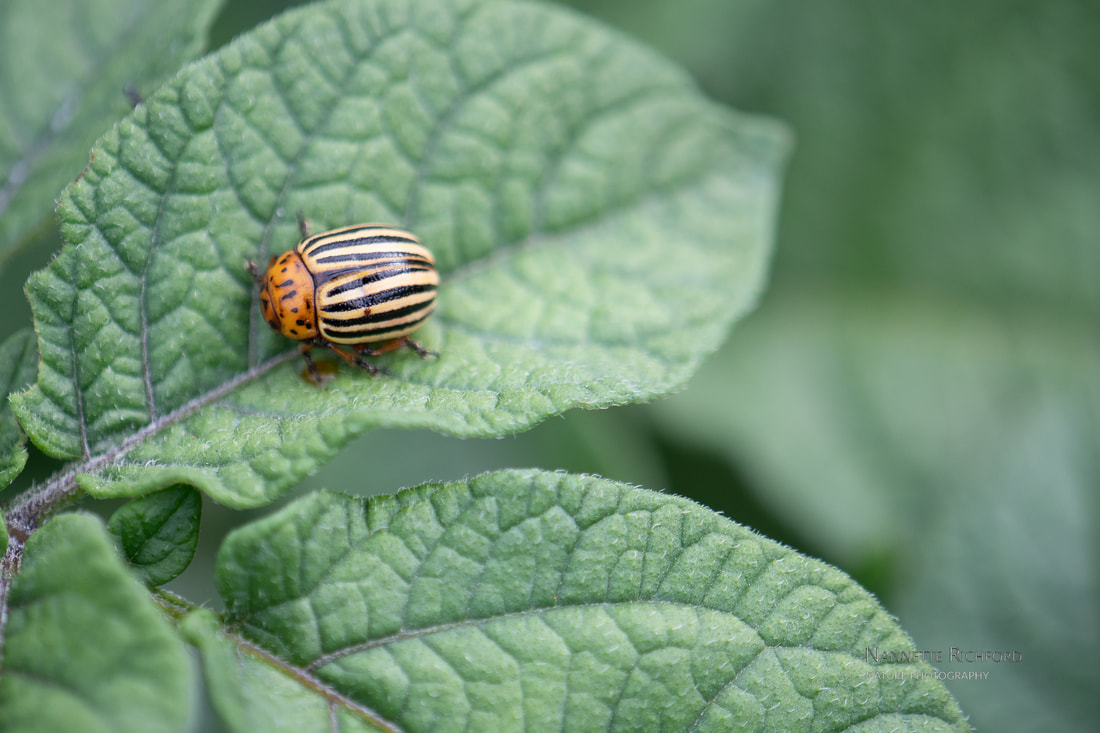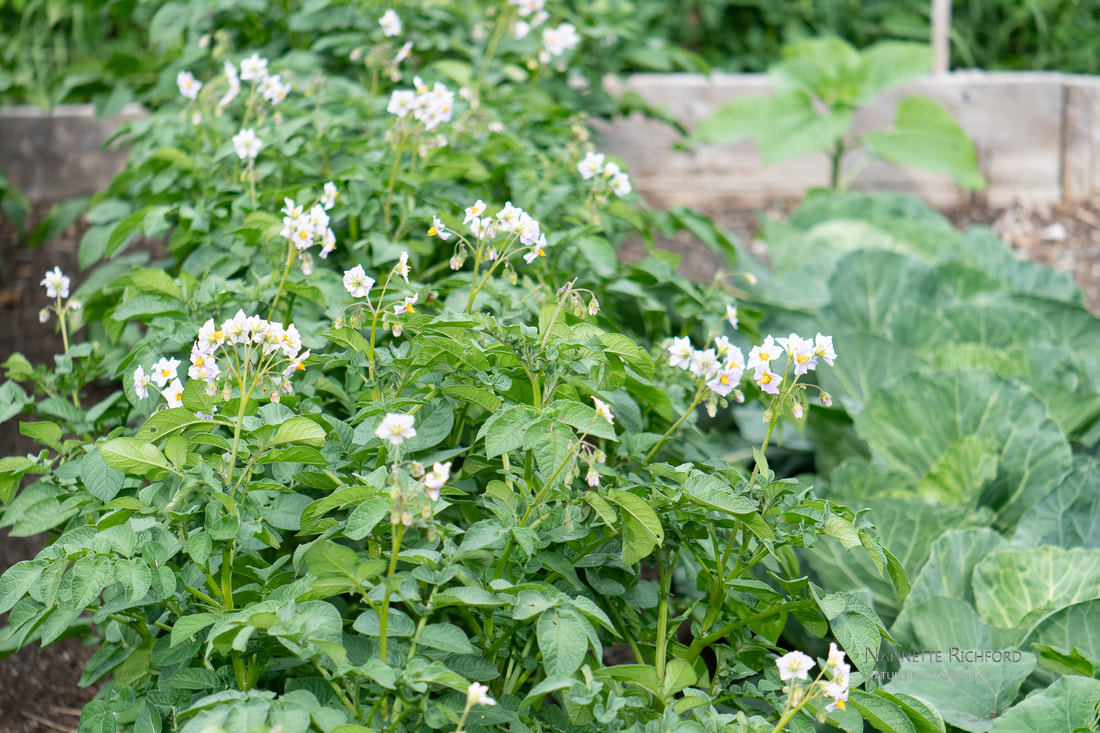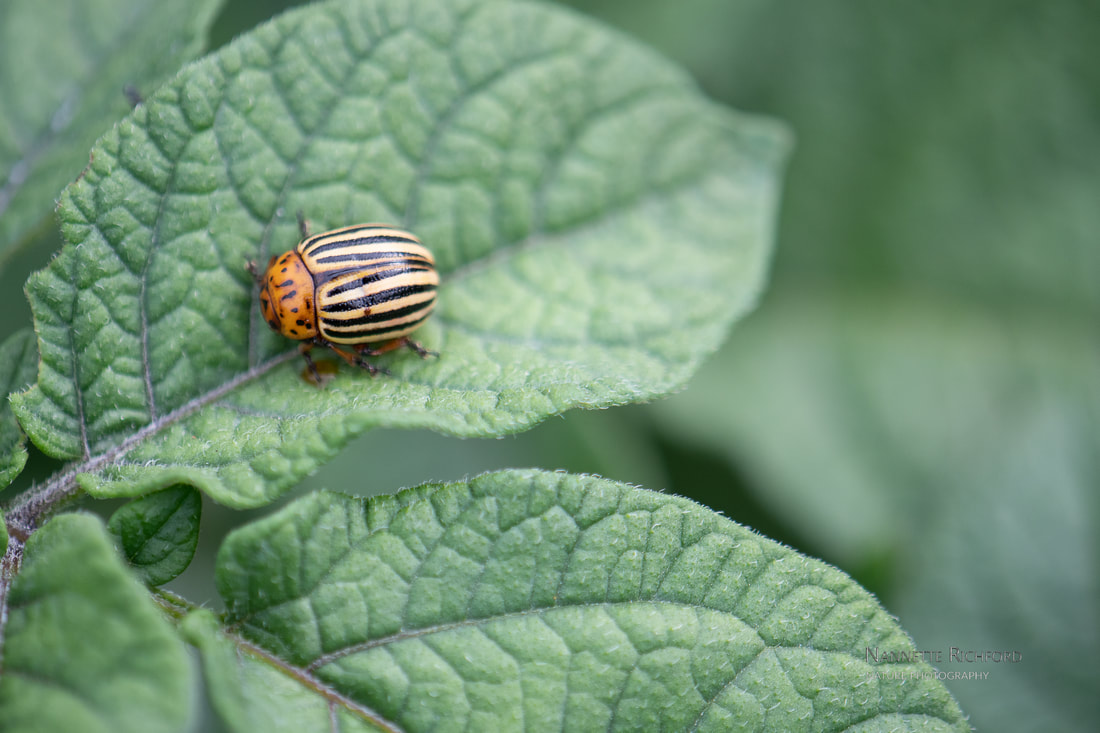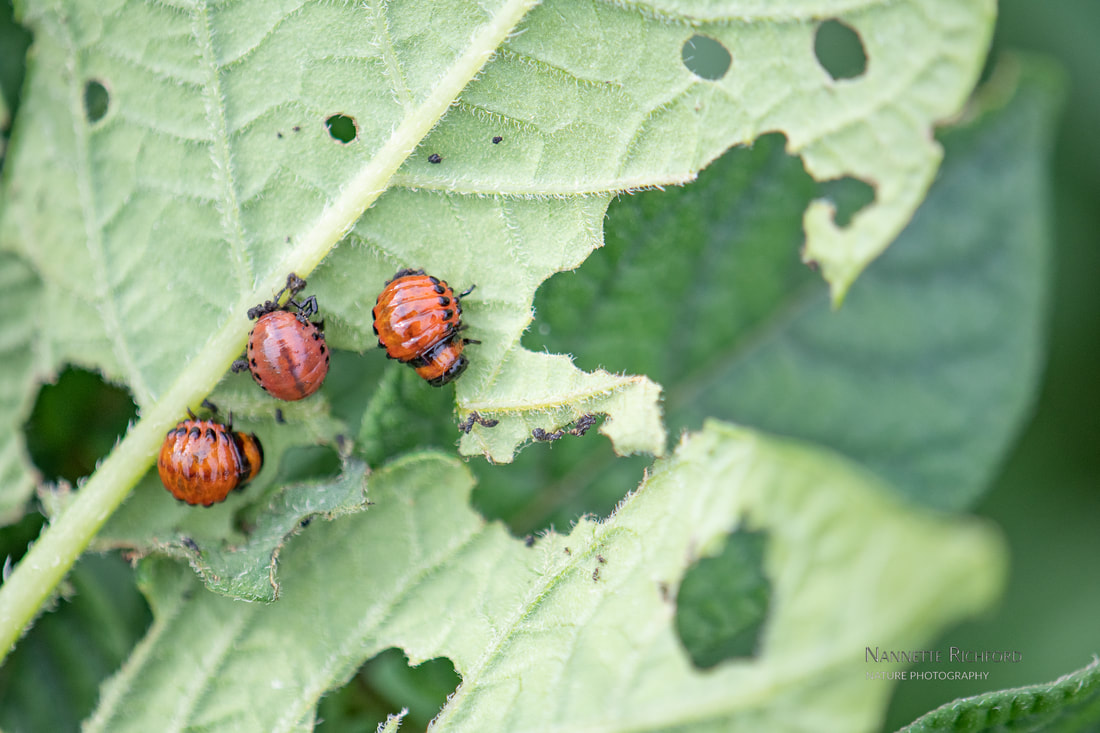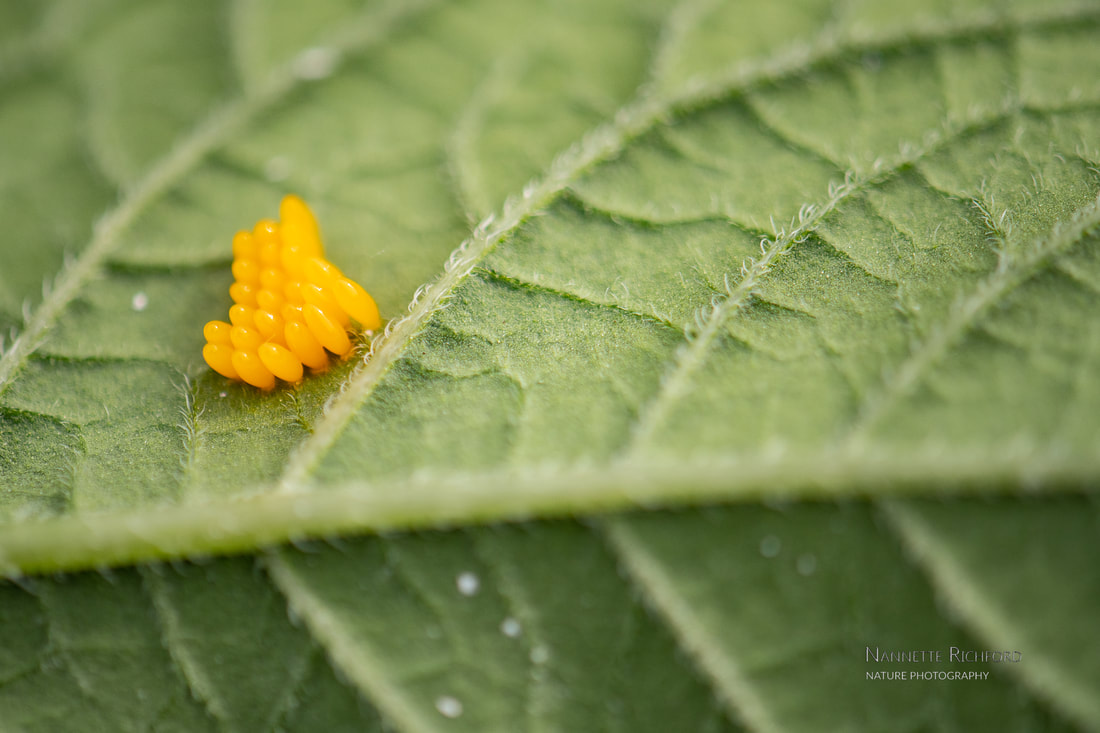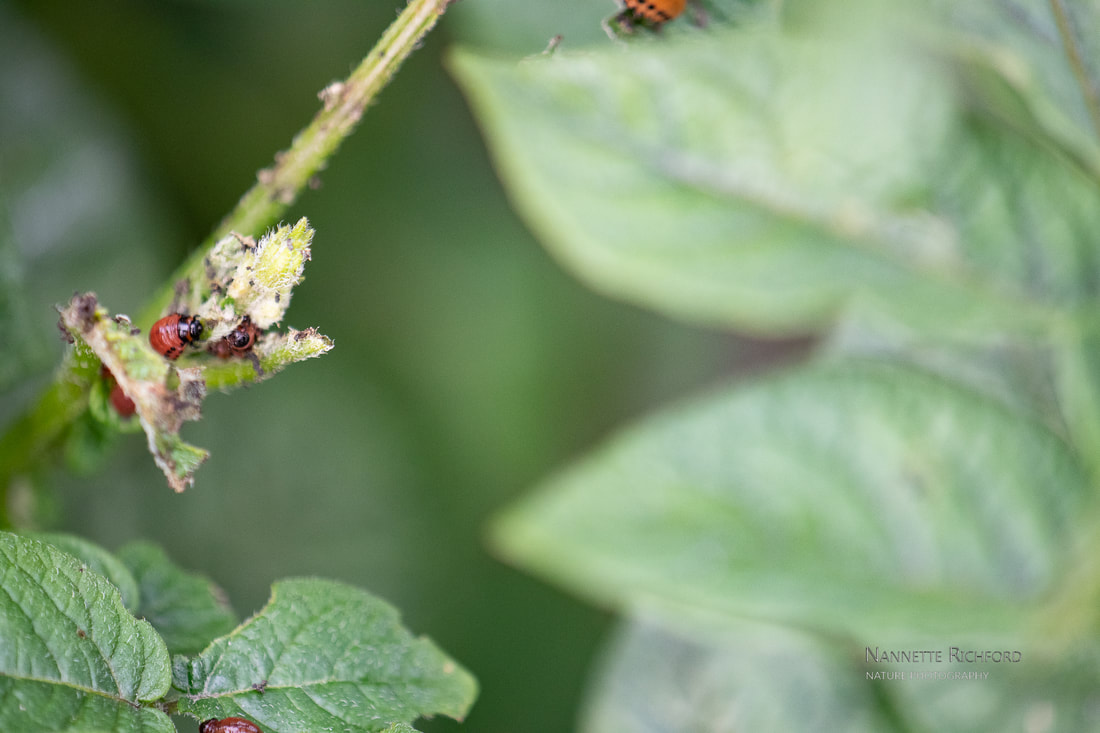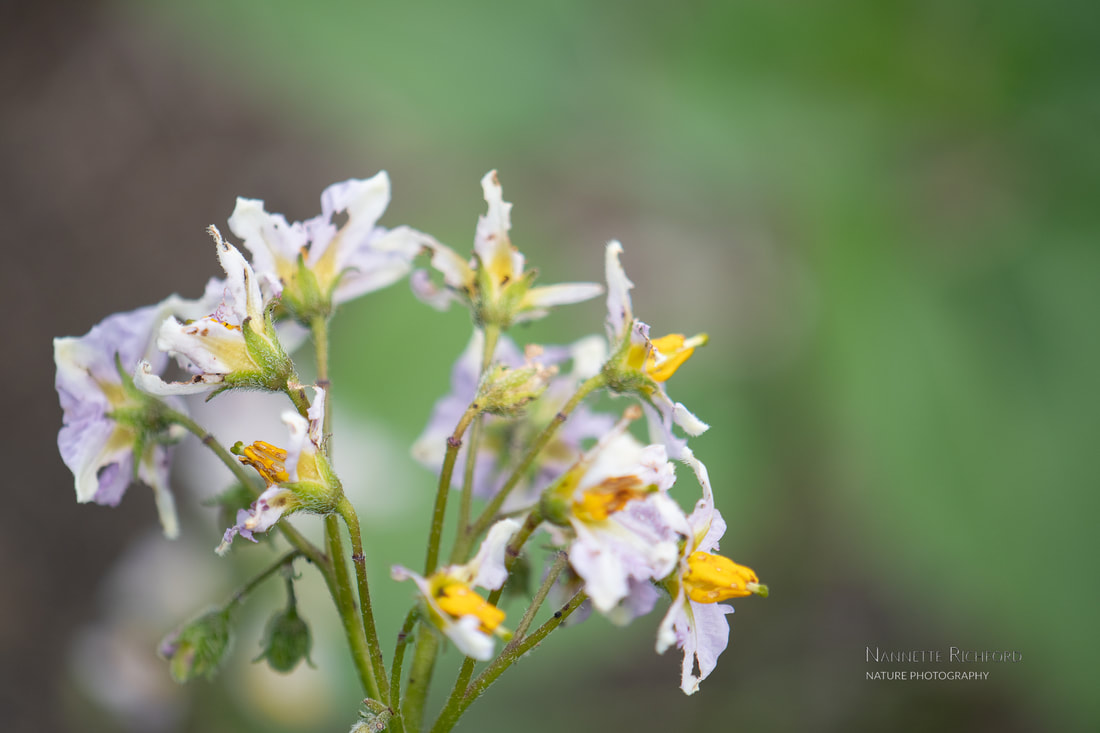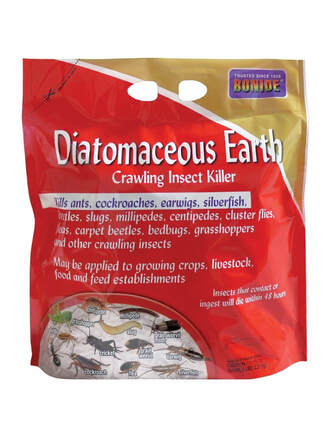- Home
- Garden Thyme Blog
- Themes
- Flowers
-
Veggies
-
Warm Season Vegetables
>
- About Beans >
- About Corn >
- Cucumbers >
- Melons
- Peppers >
- Squash >
-
Tomatoes
>
- How to Harden Off Tomato Plants
- How (and when) to Prune Tomatoes
- Magnesium Sulfate (Epsom Salt) for Tomatoes
- Blossom End Rot in Tomatoes
- Growing Cherry Tomatoes in Hanging Baskets
- 4 Best Tomatoes for Short Seasons - Early Tomatoes
- 5 Early Maturing Tomatoes for Short Season Gardening
- How to Ripen Green Tomatoes
- How to Make Sun-Dried Tomatoes at Home
- How to Grow a Pomato Plant
-
Cool Season Vegetables
>
-
Warm Season Vegetables
>
- Herbs
- Gardening Basics
- Garden Pests
- Birds
- Fiddleheads and Fairies
- About Us
- Contact Us
- How to Marinate Roasted Vegetables
How to Get Rid of Colorado Potato Beetles
Colorado Potato Beetles (Leptinotarsa decemlineata), often referred to as potato bugs, are a common pest on potato plants. The larvae devour the foliage (and blooms) of the plant. If left untreated, they can strip your plants of leaves and kill the plant. Understanding the potato bug’s life cycle is vital to your success in controlling them.
Colorado Potato Beetle (aka Potato Bugs) Life Cycle
The adults burrow into the soil (or hide under garden debris) in the fall and overwinter. They emerge in the spring at about the same time your potato plants emerge from the soil.
- The adults then mate, and the female begins laying eggs on the undersides of the potato plant’s leaves. A female potato bug typically lays eggs in clusters of about 25 and continues to lay eggs for a month or more. One female potato bug lays around 500 eggs before she dies.
- The eggs hatch in 4 to 9 days and begin eating the foliage of your potato plants.
- They continue to feed and grow for 2 to 3 weeks and then crawl into the soil, says the University of New Hampshire Extension.
- The larvae then pupate in the soil and emerge as new adults in 5 to 10 days when the breeding cycle begins all over again.
How to Get Rid of Colorado Potato Bugs
To rid your garden of potato bugs, you must break the cycle. That means you must get rid of adults, larvae, and eggs to keep them under control.
Handpicking Potato Bugs
If you are only growing a few potato plants handpicking the potato bugs and dropping them into a bucket of soapy water is an effective way to get rid of them and keep them under control. Check the plants in the morning and again in the evening.
It is also vital to check the underside of the leaves for eggs. These bright orange eggs are easy to spot. They are typically in clusters of about 25. You can either crush the eggs with your hands or cut off a section of the leaf and drop the whole thing into soapy water.
It is also vital to check the underside of the leaves for eggs. These bright orange eggs are easy to spot. They are typically in clusters of about 25. You can either crush the eggs with your hands or cut off a section of the leaf and drop the whole thing into soapy water.
Mulch
Some report success with using straw mulch under their potato plants. The mulch forms a barrier between the soil and the plants and may prevent larvae from burying into the soil and pupating.
Soap, Water, and Oil Spray
If you prefer not to touch potato bugs, spraying them with soap and oil suspended in water is an effective option. The soap and oil coat the insect’s body and block the breathing pores, killing it.
- Mix one quart of water with two teaspoons of vegetable oil and two teaspoons of dish detergent.
- Fill a spray bottle with the mixture and spray it on the potato bugs to saturate them. The solution must cover the potato bug’s body to be effective.
Pesticides
There are a host of pesticides labeled for Colorado Potato Beetles. I have found Sevin to be the most effective.
To effectively control Colorado Potato beetles with insecticides, apply them in the spring when the first potato plants break through the soil and follow the recommended reapplication times on the container.
Insecticides and pesticides can be applied at any time, but doing so early in the spring will interrupt the breeding cycle early and make controlling potato bugs easier.
To effectively control Colorado Potato beetles with insecticides, apply them in the spring when the first potato plants break through the soil and follow the recommended reapplication times on the container.
Insecticides and pesticides can be applied at any time, but doing so early in the spring will interrupt the breeding cycle early and make controlling potato bugs easier.
What do adult potato bugs look like?
Adult Colorado Potato Beetles have a hard shell like other beetles. The body is yellowish brown with ten dark stripes. The head has spots instead of stripes. Colorado Potato Beetles have wings under the hard shell and can fly but typically do not do so in the garden. When disturbed, potato bugs usually drop to the ground, where they are well camouflaged.
What do potato bug larvae look like?
The larvae have a fleshy, red-orange body with rows of black dots down the sides. The head also has black stripes. They may look like tiny specks of red when they first hatch out, but they grow rapidly and will reach the size of an adult within a week or two.
What do potato bug eggs look like?
The Colorado Potato Beetles lays clusters of 25 bright yellow-orange, oval eggs on the undersides of the leaves. The eggs are about 1mm long.
Where do potato bugs come from?
Colorado Potato Beetles overwinter in the soil and under garden debris, where they pupate and transform into adults in the spring. Adult potato bugs crawl out of the soil (or out from under garden debris) in the spring at about the same time your potatoes break through the soil. You may find potato bugs in the soil when working it and may find them on your emerging potato plants.
Adult potato bugs can fly and may fly to your garden from neighboring gardens or farms. Sometimes adult Colorado Potato Beetles fly to a new area if farmers or gardeners spray their potatoes with pesticides.
Adult potato bugs can fly and may fly to your garden from neighboring gardens or farms. Sometimes adult Colorado Potato Beetles fly to a new area if farmers or gardeners spray their potatoes with pesticides.
Will Potato Bugs kill your potato plants?
Potato bugs can defoliate your potato plants, preventing them from performing photosynthesis. In this case, your potato plants will die. However, potato plants can survive some damage from potato bugs without it compromising your crop of new potatoes.
According to Iowa State University, potato plants can tolerate up to 30% leaf loss while they are young. Once the plants have bloomed, and the tubers are forming under the soil, they become more sensitive to potato bug damage. They cannot tolerate losing more than 10% of their leaves at this stage.
According to Iowa State University, potato plants can tolerate up to 30% leaf loss while they are young. Once the plants have bloomed, and the tubers are forming under the soil, they become more sensitive to potato bug damage. They cannot tolerate losing more than 10% of their leaves at this stage.
What is a natural way to get rid of potato bugs?
Two commonly practiced natural remedies for potato bugs are handpicking them and dropping them in a bucket of soapy water or spraying them with a solution of water, dish detergent, and oil.
Other methods include mulching your potatoes with straw and sprinkling diatomaceous earth on the larvae and on the soil around your potato plants.
Removing garden debris in the fall and rotating your crops also help to control Colorado Potato Beetles.
Other methods include mulching your potatoes with straw and sprinkling diatomaceous earth on the larvae and on the soil around your potato plants.
Removing garden debris in the fall and rotating your crops also help to control Colorado Potato Beetles.
Does diatomaceous earth kill potato bugs?
Diatomaceous earth can be used to kill the potato bug larvae, but it isn’t very effective on adults because it doesn’t penetrate the hard shell. To effectively kill potato bug larvae with diatomaceous earth (DE), it works best to sprinkle it directly on the bugs. You can also apply a light layer of DE to the leaves, but this is less effective.
Sprinkling DE on the soil around your potato plants can also provide some protection as it may kill the larvae before they burrow into the soil and prevent them from pupating and turning into adult potato bugs.
Sprinkling DE on the soil around your potato plants can also provide some protection as it may kill the larvae before they burrow into the soil and prevent them from pupating and turning into adult potato bugs.
It is vital to begin checking for potato bugs as soon as your potatoes emerge in the spring and take quick action when you find one. By checking the plants morning and night and looking for eggs on the undersides of leaves, you may be able to keep them under control without using pesticides.
Copyright © 2014 Nannette Richford
- Home
- Garden Thyme Blog
- Themes
- Flowers
-
Veggies
-
Warm Season Vegetables
>
- About Beans >
- About Corn >
- Cucumbers >
- Melons
- Peppers >
- Squash >
-
Tomatoes
>
- How to Harden Off Tomato Plants
- How (and when) to Prune Tomatoes
- Magnesium Sulfate (Epsom Salt) for Tomatoes
- Blossom End Rot in Tomatoes
- Growing Cherry Tomatoes in Hanging Baskets
- 4 Best Tomatoes for Short Seasons - Early Tomatoes
- 5 Early Maturing Tomatoes for Short Season Gardening
- How to Ripen Green Tomatoes
- How to Make Sun-Dried Tomatoes at Home
- How to Grow a Pomato Plant
-
Cool Season Vegetables
>
-
Warm Season Vegetables
>
- Herbs
- Gardening Basics
- Garden Pests
- Birds
- Fiddleheads and Fairies
- About Us
- Contact Us
- How to Marinate Roasted Vegetables
